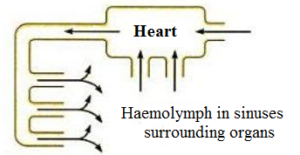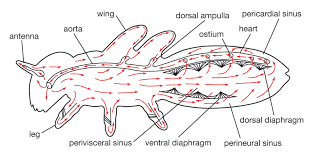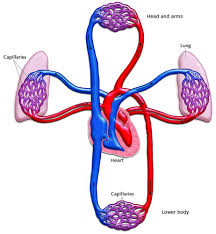Science > Biology > Human Anatomy and Physiology > Cardiovascular System > Circulatory System and its Function
In living things, many substances such as food, gases, minerals salts, hormones and waste products have to be transported from one part of the body to another. Plants and animals have a system of transporting substances throughout their body. In animals (vertebrates), blood is the medium of transport. In small animals (lower animals) such as protozoa and Flatworms, Diffusion of gases takes place through their body surface. Due to their smaller size, they lack a special system for the transport of other materials such as oxygen for existence. Higher animals have higher metabolic activity, hence higher animals require an efficient and speedy supply of nutrients and oxygen for their tissues at the same time they require efficient and speedy disposal of respiratory products, nitrogen products. Hence such animals have developed a special fluid called blood in them and conducting system called circulatory system consisting of heart, vessels etc. This system is also called a vascular system. The circulatory system has two functional components viz. a) blood vascular system and b) lymph vascular system.
Functions of the Circulatory System
Transport of oxygen:
The main function of the circulatory system is supplying oxygen to the different parts of the body. Every cell requires oxygen for their survival. Particularly the brain cells are the most sensitive and begin to die in as little as 3 minutes if deprived of oxygen. During inhalation, air enters the lungs and oxygen is absorbed through the air sacs (alveoli) into the bloodstream. Oxygen combines with the haemoglobin of RBCs to form oxyhaemoglobin. This oxygen-rich blood is pumped through the heart into the arterial circulation. In the capillaries, unstable oxyhaemoglobin breaks down into haemoglobin and oxygen. The separated oxygen diffuses out of the blood into the cells of the body’s organs and tissues where it is utilized for metabolic activities.
Transportation of Carbon dioxide:
Carbon dioxide is a waste product produced by cells during its metabolic activities. A small amount of carbon dioxide combines with haemoglobin to for carbamino-haemoglobin. Some carbon dioxide dissolves in blood plasma. The absorbed carbon dioxide in the blood is transported to the lungs through the venous circulation. When this oxygen-poor blood reaches the lungs, carbon dioxide diffuses through the air sacs (alveoli) and is then exhaled.
Transport of Nutrients:
Delivering nutrients to the body is another critical function of the cardiovascular system. After food is digested and assimilated, its component nutrients like carbohydrates, proteins, minerals, fats, and vitamins are absorbed into the bloodstream. Each of these nutrients is vital for healthy body function. Carbohydrates are a direct source of energy for the body while proteins (amino acids) are building blocks of new cells. Thus circulatory system supply nutrients wherever it is required. Like oxygen, nutrients diffuse from the bloodstream into body cells via the capillaries.
Transport of Waste Products:
The circulatory system collects metabolic waste products like urea and other chemical wastes and toxins and transports them to the liver, kidneys, skin, and lungs (excretory organs) for elimination from the body.
Transport of Hormones:
Hormones are chemical messengers produced by endocrine glands that affect distant organs. Hormones are released into the bloodstream through which they travel to target sites. Thus the cardiovascular system serves as the transportation connection between the endocrine glands and the organs or tissues. For example, Pituitary gland situated near the brain produces hormones which control other endocrine glands such as the thyroid, ovaries and testes and growth. Similarly, pancreas situated near liver produce hormone insulin which is required for maintaining blood sugar level throughout the body. The circulatory system delivers these hormones to the site of use of that hormone.
Body Temperature Regulation:
Blood Picks up excess body heat and brings it to the skin to be excreted. The sweat is formed on the skin. Which is evaporated and heat required for it is taken from the body. Hence the body cools down. Optimal function of the human body occurs within a relatively narrow temperature range, which is tightly regulated. If body temperature begins to rise, blood vessels close to the body surface dilate (increasing in size). This allows the body to get rid of an excess of heat through the skin. If body temperature drops, surface blood vessels constrict (decrease in size) to conserve body heat. Thus the cardiovascular system works in concert with the body’s sweating mechanism to regulate the body temperature
Disease Protection and Healing:
The circulatory system serves as the path for disease-fighting cells and proteins, and messengers of the immune system. WBC’s rid the body of pathogens (invading germs) in the process called phagocytosis. In this process, the WBCs surround, engulf and “eats” the invading pathogen. Thus they fight against the pathogens. On entry of germs, antibodies are produced in the blood and a chemical alarm signal is created that travel through the bloodstream, which subsequently transports antibodies to the site of the infection. The circulatory system also carries chemical messengers that attract cells to heal tissues that have been damaged due to injury or disease. It helps in clotting to heal the wound.
Maintain Haemostasis and Osmoregulation:
Homeostasis is a property of cells, tissues, and organisms that allows the maintenance and regulation of the stability and constancy needed to function properly. Homeostasis is a healthy state that is maintained by the constant adjustment of biochemical and physiological pathways. Humans’ internal body temperature, the blood sugar level, blood pressure are all maintained through homeostasis. The circulatory system plays an important role in it. The maintenance of constant osmotic pressure in the fluids of an organism by the control of water and salt concentrations is called osmoregulation. The osmotic pressure and concentrations are maintained by the circulatory system.
Types of Circulatory Systems
Higher organisms have higher metabolic activity, hence higher animals require an efficient and speedy supply of nutrients and oxygen for their tissues at the same time they require efficient and speedy disposal of respiratory products, nitrogen products. Hence such animals have developed a special fluid called blood in them and conducting system called circulatory system consisting of heart, vessels etc. This system is also called a vascular system. The circulatory system has two functional components viz. a) blood vascular system and b) lymph vascular system.
The blood vascular system is of two types a) Open circulation and b) Closed circulation
Open Circulatory System:

Open circulatory systems are the more basic type of circulatory system. In this circulatory system, the blood is not contained within an enclosed circuit of vessels. Blood (haemolymph) flows from the heart through open-ended vessels and, when it reaches the end of the vessels, The haemolymph enters into an open cavity called a haemocoel. The haemolymph mixes with interstitial fluid and moves around the haemocoel, thus bathing the internal organs and tissues. Haemolymph flows directly over the tissues delivering nutrients and in some cases, gases such as oxygen. Then the haemolymph freely flows back into vessels that direct the blood back to the heart.
The heart is simply an aorta or other blood vessels, and the haemolymph is pulsed throughout the body by muscle contractions. There are no arteries or major veins to pump the haemolymph, so blood pressure is very low and the volume of haemolymph is relatively high.

Examples: arthropods which include insects, spiders, prawns and most molluscs.
Characteristics of Open Circulatory System:
- Blood flows through large open spaces called lacunae and sinuses.
- No capillary system so tissues are in direct contact with haemolymph.
- Exchange of nutrients and gases takes place directly between haemolymph and tissue.
- The volume of haemolymph flowing through tissues cannot be controlled as hemolymph is flowing through open spaces.
- haemolymph flow is very slow. The blood pressure is very low
- Found in higher invertebrates like most arthropods such as prawns, cockroach etc. and in some molluscs.
Closed Circulatory System:
William Harvey (1578-1657) discovered and published the first accurate description of the human circulatory system, based on his many years of experiments and observations as a scientist and physician. The humans have closed circulatory system. Unlike an open circulatory system, a closed circulatory system is more structured and controlled. The blood of a closed system always flows inside vessels. These vessels make up the vessel system of the body and can be found throughout the entire body.

Characteristics of Closed Circulatory System:
- Blood flows through a closed system i.e. heart and blood vessels.
- Capillary system present so blood is not in direct contact with tissues.
- Nutrients and gases pass through the walls of capillaries to tissue fluid which is then taken up by the tissues.
- Blood flow is controlled by contraction and relaxation of muscles of blood vessels.
- Blood flow is rapid here.
- Found in some molluscs, annelids and all vertebrates.
Importance of Human Circulatory System:
Most of the cells in the human body are not in direct contact with the external environment, so rely on the circulatory system to act as a transport service for them. Two fluids move through the circulatory system: blood and lymph. The blood, heart, and blood vessels form the Cardiovascular System. The lymph, lymph nodes and lymph vessels form the Lymphatic System. The Cardiovascular System and the Lymphatic System collectively make up the Circulatory System. The system in which blood is circulated throughout the body is called the circulatory system.
Next Topic: The Blood: Overview
